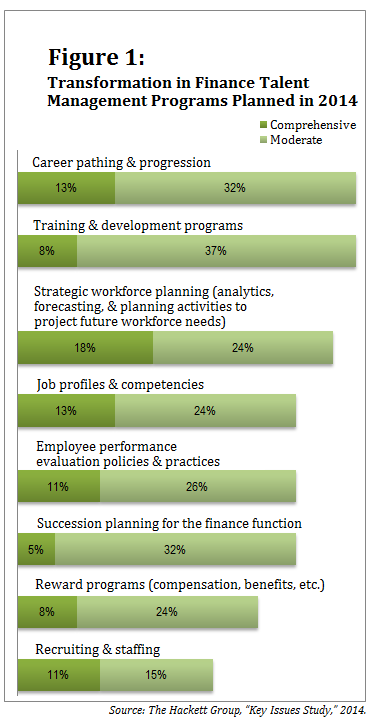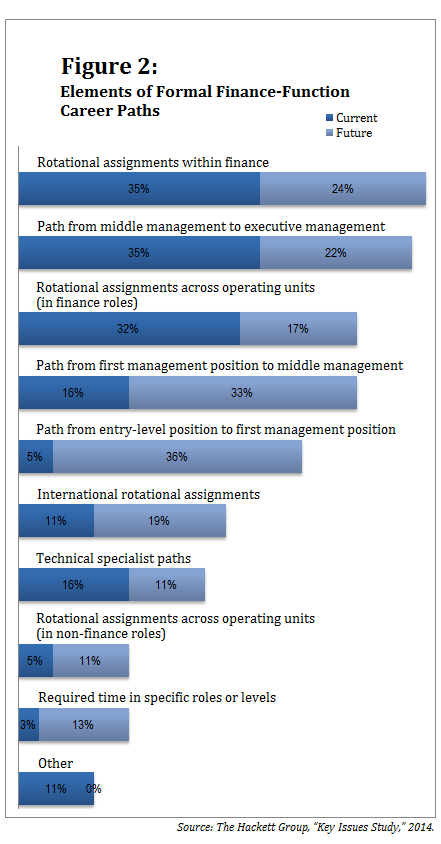 Talent is a hot topic in finance and treasury circlesthese days as executives fret about how to attract and retain theemployees they need.
Talent is a hot topic in finance and treasury circlesthese days as executives fret about how to attract and retain theemployees they need.
The buzz about talent reflects the changing set of skills thatare required as finance and treasury seek to become more strategic, and as the economy's recovery leadsfinance teams to think about hiring, even as it may encourageemployees to look for other opportunities.
|Lynne Schneider, senior research director at the Hackett Group,a business and technology consulting company, noted that in recentyears, finance budgets have been cut repeatedly or at best haveremained flat. “Finance departments didn't have money for raises,they didn't have money for learning and development,” Schneidersaid.
|With the economy picking up, finance departments are eager toadd workers with the analytical, planning, and budgeting skillsthey're looking for, she said. But given the budget constraints ofthe last few years, they're worried about their ability to retaintheir current employees and attract new ones.
|“We just hear so much from our clients about sourcing those rareskills, and fears around retention are big,” Schneider said.
|Focus on Training and Retention
A recentHackett survey shows that many finance departments are addressingthose concerns by making changes in their talent managementprograms and putting more emphasis on training and development andretention.
 Forty-five percent of thecompanies Hackett surveyed plan to make changes this year infinance career paths and in training and development programs,while 42% plan changes in their strategic workforce planning.
Forty-five percent of thecompanies Hackett surveyed plan to make changes this year infinance career paths and in training and development programs,while 42% plan changes in their strategic workforce planning.
“The look at strategic workforce planning is new anddifferent—making a plan that's not about six months from now, butone that looks more broadly at the workforce over a three- tofive-year time period,” Schneider said.
|The career paths that are seeing the most change are a littlelower on the totem pole. Sixteen percent of surveyed companiesoffer a path from an individual's first finance management positionto middle management, and another 33% plan to do so in the future.Just 5% offer a career path from entry-level finance positions to afirst management position, but another 36% plan to do so.
|“Some of the outsourcing or offshoring did get rid of some ofthe entry-level positions,” Schneider said. “It sets up more of atalent battle for those five- to 10-year experienced people.”
|The topic of talent has become “a huge point of discussion” attreasurers meetings over the last year and a half, said CraigMartin, executive director of the Association for FinancialProfessionals' Corporate Treasurers Council (CTC). In fact, thecouncil put out a guide entitled “Leadershipin Treasury: Attracting and Retaining Talent” earlier thismonth.
|Martin noted that treasury teams are small, and much of thenecessary knowledge has to be acquired on the job. “As a treasurer,you need to know your basic finance, but when it comes to managingcash, global investments, treasury technologies, hedging—thatstuff's not really taught in college.”
|But once treasury groups find promising employees and trainthem, the small size of most treasury departments may make it hardto provide promotions and retain valued employees, he said.
|According to the CTC report, career paths are a major challengefor finance departments, but also the best way for them to retainvalued employees. An AFP survey shows 33% of treasury departmentscited career paths as their biggest challenge in staff development,followed by cross training, which was cited by 16%.
|The survey shows companies use a range of approaches to motivatefinance employees, with 57% providing financial support forcontinuing education and certifications, 50% offering flexible workarrangements, and 45% providing employees with individualdevelopment plans.
|Value of Rotation
Bruce Lynn, a managing partner at the Financial ExecutivesConsulting Group, argued that a rotation program that movesexecutives between treasury and operating units not only helpsretain employees, but provides them with valuable information aboutthe company.
 “A successful treasury departmentis one in which people rotate in from the operating function of acompany, stay in treasury for a while, and then rotate back out toanother part of the company,” Lynn said.
“A successful treasury departmentis one in which people rotate in from the operating function of acompany, stay in treasury for a while, and then rotate back out toanother part of the company,” Lynn said.
Spending time in treasury teaches employees “where the cashcomes from and where it goes,” Lynn added. “Operating cash flow isthe lifeblood of a company. People who come out of anoperating area understand that, and now they get a little more of astrategic view” of cash as a result of the time they spend intreasury.
|Given that treasury departments are usually small, rotationprograms also give companies a way to enhance the career of anemployee who has nowhere to go within the treasury function, hesaid. “Some kind of rotation program is very valuable in retaininghigh-quality people.”
|Lynn cites the hypothetical case of an assistant treasurer whohopes to advance but is working for a treasurer who's just 40 yearsold and not planning to go anywhere. “How do you retain someonelike that?” Lynn said. “The only way I can think of is to say: 'Wevalue you. Why don't you go off and run this part of the company,and then come back?' If you don't do that, the guy will have toleave. From a career standpoint, he's just blocked.”
|The Hackett survey showed a fair number of companies alreadyrotate finance employees and more plan to start rotation programs.Among the companies surveyed, 35% rotate employees within financeand 24% plan to do so in the future. Thirty-two percent of thecompanies rotate finance employees to finance assignments inoperating units and 17% plan to do so in the future.
|Talent Challenges Not Limited toFinance
In a survey of CFOs by Robert Half, aprofessional staffing firm, 16% said it is very challenging to fillprofessional-level positions in general, not just financepositions, while 47% said it is somewhat challenging to fillprofessional positions.
Brett Good, a senior district president at Robert Half, said theU.S. has a dual job market, with the unemployment rates forcollege-educated professionals running at about half the generalunemployment rate.
|But Good also cited the growing need for compliance staffers andfor employees who can deal with such finance-related technologiesas ERP systems. Those jobs are competing for the new collegegraduates who might traditionally have joined finance departments,he said.
|And as the economy picks up, concerns about attracting skilledemployees are only likely to grow. Good says Robert Half is seeing“broad-based demand across the board.” While hiring isn't at thelevels seen in 1999 to 2000 or 2005 to 2006, “it's certainly a muchimproved environment than it has been in the last four or fiveyears,” he said.
Complete your profile to continue reading and get FREE access to Treasury & Risk, part of your ALM digital membership.
Your access to unlimited Treasury & Risk content isn’t changing.
Once you are an ALM digital member, you’ll receive:
- Critical Treasury & Risk information including in-depth analysis of treasury and finance best practices, case studies with corporate innovators, informative newsletters, educational webcasts and videos, and resources from industry leaders.
- Exclusive discounts on ALM and Treasury & Risk events.
- Access to other award-winning ALM websites including PropertyCasualty360.com and Law.com.
*May exclude premium content
Already have an account? Sign In
© 2024 ALM Global, LLC, All Rights Reserved. Request academic re-use from www.copyright.com. All other uses, submit a request to [email protected]. For more information visit Asset & Logo Licensing.







